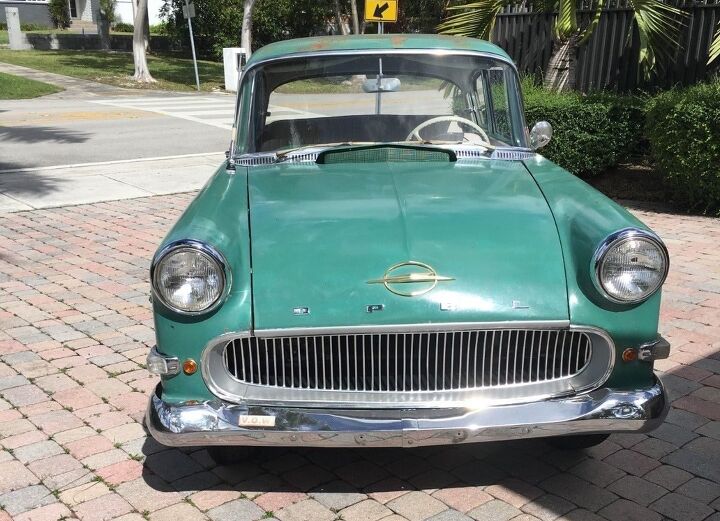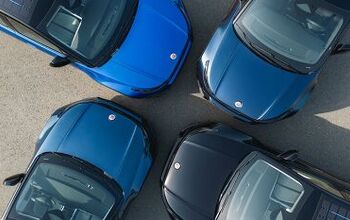Rare Rides: Take Note of a 1960 Opel Rekord

Long before Opel became a donor for the badge-engineered Cadillac Catera and Buick Regal, the then GM-owned company shifted its own cars on North American soil. Today’s Rare Ride is a very early example of such a North American offering: It’s a two-door Rekord sedan from 1960.
The first Opels arrived on North American shores circa 1958. They wore their Opel badging proudly, and were distributed via Buick dealerships who’d signed on for some additional German flair in the showroom.
By that time, the Rekord model was in its second generation. The model started off as a compact executive car aimed at the European market in 1953. Originally known as the Olympia Rekord, the model’s success warranted a follow-up album. The new one bore the name Rekord P1 (initially Rekord P), and the small sedan was introduced in 1957 at the Frankfort Motor Show.
Larger than its predecessor, the new Rekord took its styling inspiration from popular large American cars of the day. Windows at the front and rear were of a wrap-around style, aping American favorites like the Buick Roadmaster and Chevrolet Bel Air. Other American car features included daring two-tone paint and matching two-tone interiors.
The model found quick success, earning a repeated second place finish on the West German sales charts. Rekord was bested only by the less expensive VW Beetle. German journalists of the day gave the Rekord a special pet name too: “Bauern-Buick,” or “Peasant’s Buick.” Charming.
The two-door sedan style was the only one available for 1957. The next year, a four-door sedan, a three-door station wagon, and a panel van debuted. Engines supplied to the Rekord varied by build date and trim level. All were inline-fours ranging from 1.2 to 1.7 liters in displacement. A single transmission was available for the majority of the Rekords produced — a three-speed manual. While an automated manual entered service for 1959 and 1960, it proved an unpopular option.
The second-generation Rekord was short-lived, and a third generation (the P2) was ready by summer of 1960. Growing larger and more luxurious with each successive model, Opel produced eight different generations of the Rekord, spanning the years 1953 to 1986. It eventually replaced the model with the Omega, which you’ll remember as the Cadillac Catera.
Today’s Rare Ride is a 1960 example, from very late in the second generation’s run. It’s a base model Olympia trim, meaning it has the smaller 1.2-liter engine. In monochromatic green and decent condition, it asked $5,000 on eBay recently. It received no bids.
[Images: eBay]

Interested in lots of cars and their various historical contexts. Started writing articles for TTAC in late 2016, when my first posts were QOTDs. From there I started a few new series like Rare Rides, Buy/Drive/Burn, Abandoned History, and most recently Rare Rides Icons. Operating from a home base in Cincinnati, Ohio, a relative auto journalist dead zone. Many of my articles are prompted by something I'll see on social media that sparks my interest and causes me to research. Finding articles and information from the early days of the internet and beyond that covers the little details lost to time: trim packages, color and wheel choices, interior fabrics. Beyond those, I'm fascinated by automotive industry experiments, both failures and successes. Lately I've taken an interest in AI, and generating "what if" type images for car models long dead. Reincarnating a modern Toyota Paseo, Lincoln Mark IX, or Isuzu Trooper through a text prompt is fun. Fun to post them on Twitter too, and watch people overreact. To that end, the social media I use most is Twitter, @CoreyLewis86. I also contribute pieces for Forbes Wheels and Forbes Home.
More by Corey Lewis
Latest Car Reviews
Read moreLatest Product Reviews
Read moreRecent Comments
- 3-On-The-Tree My experience with turbos is that they don’t give good mpg.
- GregLocock They will unless you don't let them. Every car manufacturing country around the world protects their local manufacturers by a mixture of legal and quasi legal measures. The exception was Australia which used to be able to design and manufacture every component in a car (slight exaggeration) and did so for many years protected by local design rules and enormous tariffs. In a fit of ideological purity the tariffs were removed and the industry went down the plughole, as predicted. This was followed by the precision machine shops who made the tooling, and then the aircraft maintenance business went because the machine shops were closed. Also of course many of the other suppliers closed.The Chinese have the following advantagesSlave laborCheap electricityZero respect for IPLong term planning
- MaintenanceCosts Yes, and our response is making it worse.In the rest of the world, all legacy brands are soon going to be what Volvo is today: a friendly Western name on products built more cheaply in China or in companies that are competing with China from the bottom on the cost side (Vietnam, India, etc.) This is already more or less the case in the Chinese market, will soon be the case in other Asian markets, and is eventually coming to the EU market.We are going to try to resist in the US market with politicians' crack - that is, tariffs. Economists don't really disagree on tariffs anymore. Their effect is to depress overall economic activity while sharply raising consumer prices in the tariff-imposing jurisdiction.The effect will be that we will mostly drive U.S.-built cars, but they will be inferior to those built in the rest of the world and will cost 3x-4x as much. Are you ready for your BMW X5 to be three versions old and cost $200k? Because on the current path that is what's coming. It may be overpriced crap that can't be sold in any other world market, but, hey, it was built in South Carolina.The right way to resist would be to try to form our own alliances with the low-cost producers, in which we open our markets to them while requiring adherence to basic labor and environmental standards. But Uncle Joe isn't quite ready to sign that kind of trade agreement, while the orange guy just wants to tell those countries to GFY and hitch up with China if they want a friend.
- CEastwood Thy won't get recruits who want to become police officers . They'll get nuts who want to become The Green Hornet .
- 1995 SC I stand by my assessment that Toyota put a bunch of "seasoned citizens" that cared not one iota about cars, asked them what they wanted and built it. This was the result. This thing makes a Honda Crosstour or whatever it was look like a Jag E type by comparison.







































Comments
Join the conversation
"Engines supplied to the Rekord varied by build date and trim level. All were inline-fours ranging from 1.2 to 1.7 liters in displacement." ...And I'm proud to be an American...
The Rambler American was a much better car than this and probably got better mpgs.